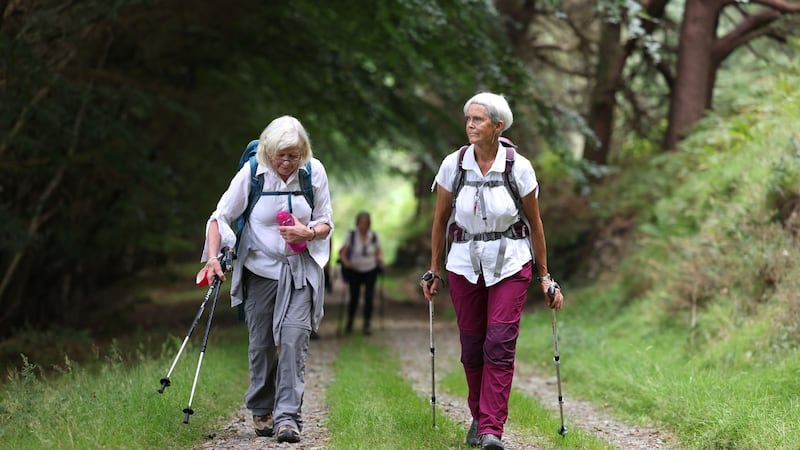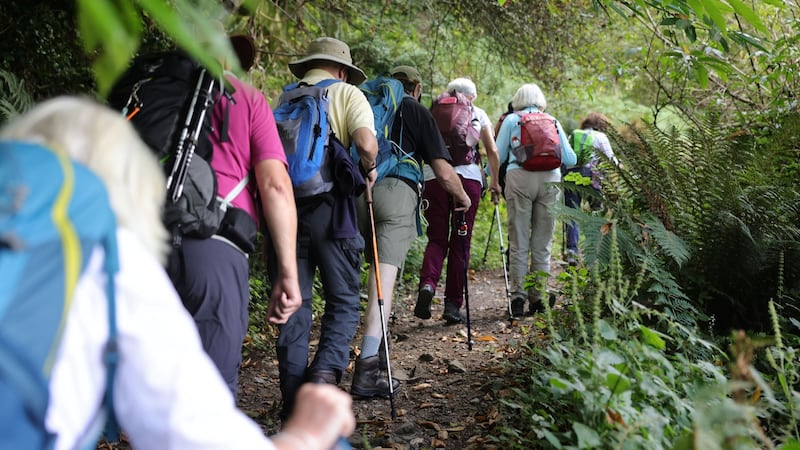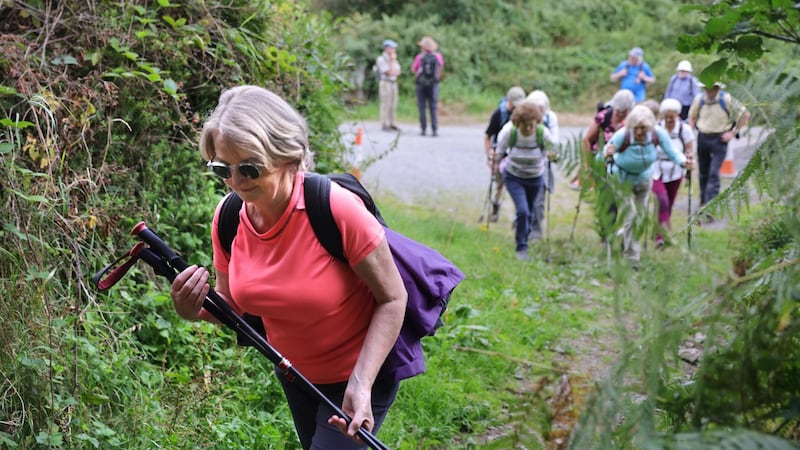I was warned of “a bit of pull” for the first 3km. Later Paddy MacManus, leading the walk, warns of “a strong pull” ahead. But visions of hanging off the side of a cliff face faded fast; turns out a bit of a pull is no biggie.
It's a crisp, sunny autumn morning and about 15 members of Co Dublin's Trekkers Mountaineering Club are walking part of the Wicklow Way, starting at Annamoe. MacManus is leader and Mary Murray is sweeping, ensuring everyone is safe. It's a rag-taggle band, a warm and welcoming lot who know each other from many hours and chats over numerous walks. There's banter and slag and serious talk, while keeping up a good pace, with occasional water stops.
We’re a C walking group (forest tracks, trails, quiet roads, relatively gentle gradients). Trekkers categorise walks on terrain and level of challenge: Grade A involves steep gradients, mountain summits, open hillside for up to eight hours; B has fewer summits, for up to six hours. There are also gentle social walks of up to 6km.
I’m a try-out – you can sample a few walks before joining – so I’m with the Cs, bit of a pull or not.
The advance description is precise: leaders put impressive preparation into reconnaissance (recce), mapping terrain, planning stops, anticipating issues. Thus before setting out I know it’ll be 11.8km, about 3.8 hours, basic route and terrain. It’s a loop walk, ending where we started, a necessity while bus hire is restricted. Loops narrow the route options, so members look forward to getting back to bussing to a start point, with pick-up elsewhere. Nonetheless, there’s delight to be back out on the path. With reduced group sizes for Covid, trekkers added more walks; by now there are five or six weekly.
Sun-screened, booted and sticked up, we’re in a beautiful part of the world, and heading deeper into it, enjoying pleasures on our doorstep: the exhilaration of nature and mountain and fresh air, perfectly packaged in a walk that challenges.
The chat is varied as we wend our way, from pedestrianisation and cycle lanes to American politics, to trekking in the Himalayas.
Murray, sweeping, joined the club about 20 years ago with her late husband Tom, and was the first woman in the chair, 15 years ago. “I love the walking,” she says. “And also the company. I’ve gone on lots of holidays with the club.” Her son Dermot Murray is an A walker. “He’s really knowledgeable,” says Fiona O’Sullivan. “He knows every single mountain.”



Eudie Power, a daily swimmer, has walked with the club for years. “I’m not a leader, I’m like a child, I need to be taken!” When she joined “it was mostly men and they always wanted to lead, whereas now it’s reversed, there are more women leaders. And they’re looking for the next generation of good walkers.”
Suzie Kennedy is talking about a wedding she conducted recently. Noreen O’Brien recalls early days in the club, founded by Shaun Trant in 1982. It was men only, “but women were invited to a Christmas dinner”; women started walking with the club “decades ago”, O’Brien reckons.
Walkers debate the merits of wearing boots in your shoe size with double-lined socks, versus a couple of sizes too big with extra socks. Nick O’Loughlin’s boots are 11 years old. He walks several times a week. “If I had a mileometer on them, they would talk.”
What’s the club’s appeal – the walking, the fresh air and nature, the company, how walks are organised? It’s all of that, various people agree. There’s no clique, and the committee rotates, says O’Brien. “It’s a very well organised club,” says O’Loughlin. He’s only been a member three years, he says. “It feels much longer!” O’Brien teases, quick as you like.
We come upon a bit of commotion. Walkers are gathered around a giant mushroom Power has spotted. “Oh, we’re not touching it.” “It’s like a face.” “Eudie loves picking things up on walks. She’s a forager.” Will you eat it, I wonder. “Oh no, I dry things and paint a bit.”
Then someone calls: “Car, folks!” We pull in, then move on.
Members recall walking trips: around Ireland (Leenane in Connemara; “the Slieve Blooms are magnificent around April with the bluebells”, says Fiona O’Sullivan). And further afield, to the Pyrenees (organised by Michael and Josephine Cotter), America, a “fabulous walk” in the Yorkshire hills organised by McManus. The trips will return: O’Loughlin and Murphy plan to lead a walking holiday to Crete next May.
Maeve O’Donnell says “I dip in and dip out, I’d like to be a bit more consistent.” John O’Neill is talking about kites (the birds not the toys) overhead. For him the appeal is “a bit of activity, looking at nature, talking nonsense”. Plus: “No one has an agenda, there’s no rows. People just want the fresh air, walk a few hills, get the heart going and we’re all happy.”
Paula Clancy, a comparative newbie, joined shortly before Covid. “It’s like going to a party twice a week! You chat to people like you do at a party, it’s not demanding, everybody’s very friendly. But it’s primarily the exercise.”
We’re coming up to Brusher’s Gap, a junction with a Mountain Meitheal shelter, where three trails come together. MacManus shows me his detailed route card: stages, co-ordinates, elapsed time, distance, ascent. The ViewRanger app is “a recording of what we’ve done. But paper is primary.” We’ll go downhill to a forest, cross the Avonmore, lunch at the top of the river and a short walk back to Annamoe. (Or that’s the gist; his route plan is way more detailed.) “We manage the people to their expectations,” he observes of leading a walk.


Fiona O’Sullivan has been in trekkers six years, and chairwoman all through Covid, heading “a really, really good committee”. Though the club is based in Glenageary, some walkers travel a distance, the 170 members a mix of regular and occasional walkers. “It’s a varied membership, so many careers and experiences,” says O’Sullivan.
“I love nature and being out. But I’m not a solo walker. There’s a camaraderie.” She’s “a B walker, an A the odd time. There’s a really strong, small group of As. They’ve one walk a month and would be out for eight or 10 hours, mountain climbing, not much on trails and tracks, making it as challenging as possible. B is a faster pace than C, climbing heights. We’re trying to encourage more A and B walkers – they are the future of the club.”
To lead a walk, you plan it on a map, then test your route card on a recce. “The leader is responsible. People say when you’re leading a walk you’re not really there to enjoy it, but to make sure everybody else is enjoying it.”
Skills renewal is key. With walks halted during the 5km pandemic limit, there was time to reflect. Frances O’Rourke’s newsletter kept people in touch, and a survey showed members wanted “more walks, the buses back. And they’re dying for away trips.”
Last June trekkers celebrated 3,000 walks since inception, and on September 11th its annual memorial walk to Glenmalure Lodge remembered those who died while members: Brendan Bracken (“he was adored in the club, a great raconteur, great at finding unusual walks”), Michael Cotter who organised “wonderful away trips”, John Furey.
O’Sullivan has prioritised education. During lockdown club secretary Alan Kane (“great on detail, a super leader of walks”) and treasurer Mark Taylor (“brilliant at navigation”) put together an extensive navigation and map-reading course for 22 trekkers on Zoom over 12 weeks, correcting route-card “homework”; it was “incredible and an enormous commitment”.
The lockdown course increased the range of leaders and routes. “When you join trekkers, the expectation is that when you’re able you will lead too.”
O’Sullivan leads a B walk near us, and though it’s familiar, “I’d still have to recce it, to know that gate still opens, or where there’s a stile”, plus, to find a “banana break” spot and shelter for lunch. “A lot of people have made very good friends out of trekkers. There’s always crack. There’s prattle, and there’s good debate going on as well.”
- Trekkers is open to new members, particularly A and B walkers. trekkers.ie, email trekkersmountaineeringclub@gmail.com









